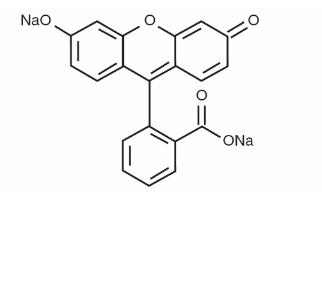Fluorescein (Ophthalmic)
Editor-In-Chief: C. Michael Gibson, M.S., M.D. [1]; Associate Editor(s)-in-Chief: Ammu Susheela, M.D. [2]
Disclaimer
WikiDoc MAKES NO GUARANTEE OF VALIDITY. WikiDoc is not a professional health care provider, nor is it a suitable replacement for a licensed healthcare provider. WikiDoc is intended to be an educational tool, not a tool for any form of healthcare delivery. The educational content on WikiDoc drug pages is based upon the FDA package insert, National Library of Medicine content and practice guidelines / consensus statements. WikiDoc does not promote the administration of any medication or device that is not consistent with its labeling. Please read our full disclaimer here.
Overview
Fluorescein (Ophthalmic) is a contrast media that is FDA approved for the diagnosis of for testing tear film stability by determining the fluorescein break-up time (FBUT). Common adverse reactions include hypersensitivity.
Adult Indications and Dosage
FDA-Labeled Indications and Dosage (Adult)
Indication
- For testing tear film stability by determining the fluorescein break-up time (FBUT).
Off-Label Use and Dosage (Adult)
Guideline-Supported Use
There is limited information regarding Off-Label Guideline-Supported Use of Fluorescein (Ophthalmic) in adult patients.
Non–Guideline-Supported Use
There is limited information regarding Off-Label Non–Guideline-Supported Use of Fluorescein (Ophthalmic) in adult patients.
Pediatric Indications and Dosage
FDA-Labeled Indications and Dosage (Pediatric)
There is limited information regarding FDA-Labeled Use of Fluorescein (Ophthalmic) in pediatric patients.
Off-Label Use and Dosage (Pediatric)
Guideline-Supported Use
There is limited information regarding Off-Label Guideline-Supported Use of Fluorescein (Ophthalmic) in pediatric patients.
Non–Guideline-Supported Use
There is limited information regarding Off-Label Non–Guideline-Supported Use of Fluorescein (Ophthalmic) in pediatric patients.
Contraindications
- Hypersensitivity to components or mercury-containing compounds.
Warnings
There is limited information regarding Fluorescein (Ophthalmic) Warnings' in the drug label.
Adverse Reactions
Clinical Trials Experience
There is limited information regarding Clinical Trial Experience of Fluorescein (Ophthalmic) in the drug label.
Postmarketing Experience
Drug Interactions
There is limited information regarding Fluorescein (Ophthalmic) Drug Interactions in the drug label.
Use in Specific Populations
Pregnancy
- Pregnancy Category
- Australian Drug Evaluation Committee (ADEC) Pregnancy Category
There is no Australian Drug Evaluation Committee (ADEC) guidance on usage of Fluorescein (Ophthalmic) in women who are pregnant.
Labor and Delivery
There is no FDA guidance on use of Fluorescein (Ophthalmic) during labor and delivery.
Nursing Mothers
There is no FDA guidance on the use of Fluorescein (Ophthalmic) with respect to nursing mothers.
Pediatric Use
There is no FDA guidance on the use of Fluorescein (Ophthalmic) with respect to pediatric patients.
Geriatic Use
There is no FDA guidance on the use of Fluorescein (Ophthalmic) with respect to geriatric patients.
Gender
There is no FDA guidance on the use of Fluorescein (Ophthalmic) with respect to specific gender populations.
Race
There is no FDA guidance on the use of Fluorescein (Ophthalmic) with respect to specific racial populations.
Renal Impairment
There is no FDA guidance on the use of Fluorescein (Ophthalmic) in patients with renal impairment.
Hepatic Impairment
There is no FDA guidance on the use of Fluorescein (Ophthalmic) in patients with hepatic impairment.
Females of Reproductive Potential and Males
There is no FDA guidance on the use of Fluorescein (Ophthalmic) in women of reproductive potentials and males.
Immunocompromised Patients
There is no FDA guidance one the use of Fluorescein (Ophthalmic) in patients who are immunocompromised.
Administration and Monitoring
Administration
Monitoring
There is limited information regarding Monitoring of Fluorescein (Ophthalmic) in the drug label.
IV Compatibility
There is limited information regarding IV Compatibility of Fluorescein (Ophthalmic) in the drug label.
Overdosage
There is limited information regarding Fluorescein (Ophthalmic) overdosage. If you suspect drug poisoning or overdose, please contact the National Poison Help hotline (1-800-222-1222) immediately.
Pharmacology
Mechanism of Action
- Fluorescein sodium responds to electromagnetic radiation and light between the wavelengths of 465-490 nm and fluoresces, i.e., emits light at wavelengths of 520-530 nm. Thus, the hydrocarbon is excited by blue light and emits light that appears yellowish-green. Following intravenous injection of fluorescein sodium in an aqueous solution, the unbound fraction of the fluorescein can be excited with a blue light flash from a fundus camera as it circulates through the ocular vasculature, and the yellowish green fluorescence of the dye is captured by the camera. In the fundus, the fluorescence of the dye demarcates the retinal and/or choroidal vasculature under observation, distinguishing it from adjacent areas/structures.
Structure
Pharmacodynamics
There is limited information regarding Pharmacodynamics of Fluorescein (Ophthalmic) in the drug label.
Pharmacokinetics
There is limited information regarding Pharmacokinetics of Fluorescein (Ophthalmic) in the drug label.
Nonclinical Toxicology
There is limited information regarding Nonclinical Toxicology of Fluorescein (Ophthalmic) in the drug label.
Clinical Studies
There is limited information regarding Clinical Studies of Fluorescein (Ophthalmic) in the drug label.
How Supplied
- Carton of 50 pouches of two strips each.
Storage
There is limited information regarding Fluorescein (Ophthalmic) Storage in the drug label.
Images
Drug Images
{{#ask: Page Name::Fluorescein (Ophthalmic) |?Pill Name |?Drug Name |?Pill Ingred |?Pill Imprint |?Pill Dosage |?Pill Color |?Pill Shape |?Pill Size (mm) |?Pill Scoring |?NDC |?Drug Author |format=template |template=DrugPageImages |mainlabel=- |sort=Pill Name }}
Package and Label Display Panel


{{#ask: Label Page::Fluorescein (Ophthalmic) |?Label Name |format=template |template=DrugLabelImages |mainlabel=- |sort=Label Page }}
Patient Counseling Information
There is limited information regarding Patient Counseling Information of Fluorescein (Ophthalmic) in the drug label.
Precautions with Alcohol
- Alcohol-Fluorescein (Ophthalmic) interaction has not been established. Talk to your doctor about the effects of taking alcohol with this medication.
Brand Names
- DRY EYE TEST®[1]
Look-Alike Drug Names
There is limited information regarding Fluorescein (Ophthalmic) Look-Alike Drug Names in the drug label.
Drug Shortage Status
Price
References
The contents of this FDA label are provided by the National Library of Medicine.

